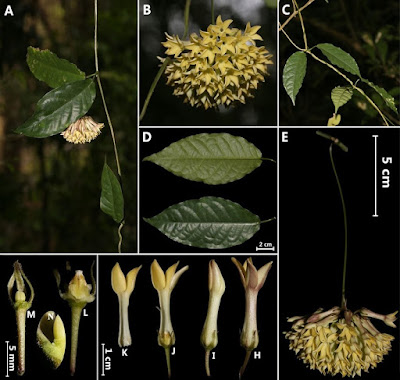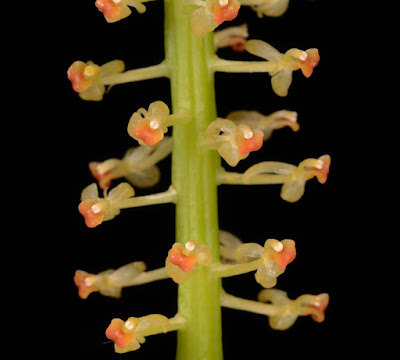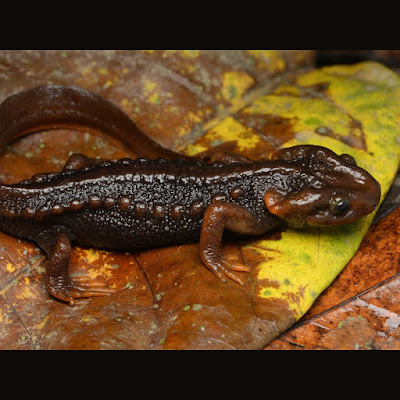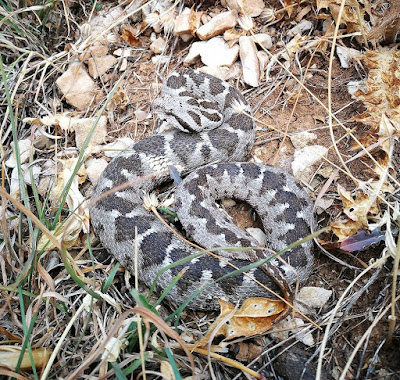[Most Recent Entries] [Calendar View]
Tuesday, October 22nd, 2019
| Time | Event | ||||
| 8:19a | [Botany • 2019] Jasminanthes laotica (Apocynaceae, Asclepiadoideae) • The First New Species of Jasminanthes described from Laos
Abstract Jasminanthes laotica (Apocynaceae, Asclepiadoideae), a new species from northern Laos is described, illustrated and a diagnostic key to the species of Jasminanthes Blume is given in this paper. J. laotica is allied to J. xuanlienensis T.B. Tran & Rodda, but can be distinguished by its longer sepals, obtuse to subcordate lamina base, and bright yellow of the inner corolla lobes, salmon-pink of the outer corolla lobes. Keywords: Marsdenieae, New record genus, Nam Ha National Bio-Diversity Park, Taxonomy, Eudicots Jasminanthes laotica Y.H. Tan & H.B. Ding, sp. nov. Ding Hong Bo, Yang Bin, Xiao-Dong Zeng and Yunhong Tan. 2019. Jasminanthes laotica (Apocynaceae, Asclepiadoideae), The First New Species of Jasminanthes described from Laos. Phytotaxa. 393(3); 297-300. DOI: 10.11646/phytotaxa.393.3.7 | ||||
| 10:06a | [Botany • 2019] A Taxonomic Revision of Liparis (Orchidaceae: Epidendroideae: Malaxideae) in Thailand
Abstract Following a historical outline, the methods and results of a taxonomic revision of Liparis in Thailand are presented. Applying the traditional methods and techniques of morphology-based botanical revision work, the revision mainly relied on examination of dried and liquid-preserved specimens from 13 herbaria. However, the herbarium studies were supplemented with observations of live plants made during 24 field trips to five of the seven floristic regions of Thailand. The taxonomic value of selected morphological characters is assessed, and ecological aspects are surveyed together with occurrence patterns in Thailand and the overall geographic affinities of the Liparis species represented in the Thai flora. Thirty-seven species are accepted, whereas reports of L. distans and L. kwangtungensis from Thailand are treated as dubious. One new species, Liparis buddhawongii, is described as new, based on material from Doi Ang Khang in Chiang Mai province. Full taxonomic accounts are provided for the genus and species, including a dichotomous key to the species. Whereas the synonymies are intended to be complete, all morphological descriptions have been prepared exclusively from Thai material. The accepted names L. balansae and L. resupinata are lectotypified, whereas a neotype is designated for L. ferruginea; L. downii and L. melanoglossa are proposed as new taxonomic (heterotypic) synonyms. All accepted species are illustrated by line drawings, and references are provided to additional good illustrations in the literature. Keywords: taxonomy, typification, Monocots, Asparagales Naiyana Tetsana, Kitichate Sridith, Santi Watthana and Henrik Æ. Pedersen. 2019. A Taxonomic Revision of Liparis (Orchidaceae: Epidendroideae: Malaxideae) in Thailand. Phytotaxa. 421(1); 1–65. DOI: 10.11646/phytotaxa.421.1.1 | ||||
| 10:24a | [Herpetology • 2019] Tylototriton kachinorum • A New Species of Crocodile Newt, Genus Tylototriton (Caudata, Salamandridae) from the Mountains of Kachin State, northern Myanmar
Abstract We describe a new species of the genus Tylototriton from Ingyin Taung Mt., Mohnyin Township, Kachin State, Myanmar, based on morphological and molecular evidence. The new species is assigned to the subgenus Tylototriton s. str. and is clearly distinct from all known congeners by the following characters: medium body size; thin, long tail, lacking lateral grooves; rough skin; truncate snout; wide, protruding supratemporal bony ridges on head, beginning at anterior corner of orbit; weak, almost indistinct sagittal ridge; long, thin limbs, broadly overlapping when adpressed along body; distinct, wide, non-segmented vertebral ridge; 13 or 14 rib nodules; brown to dark-brown background coloration with dull orange-brown to yellowish-brown markings on labial regions, parotoids, rib nodules, whole limbs, vent, and ventral tail ridge. We also briefly discuss biogeography and species diversity of the genus Tylototriton in Myanmar. Key words: Tylototriton kachinorum sp. nov., mtDNA genealogy, ND2, 16S rRNA, Shan, Biogeography, Endemism, Taxonomy
Tylototriton kachinorum sp. nov. Diagnosis: The new species is assigned to the genus Tylototriton based on molecular data and by the following combination of morphological attributes: (1) presence of dorsal granules, (2) dorsolateral bony ridges on head, (3) presence of dorsolateral series of knob-like warts (rib nodules); and (4) absence of quadrate spine (Figure 2). Tylototriton kachinorum sp. nov. is distinguished from all other congeners by a combination of the following morphological attributes: (1) medium body size, adult SVL 62.3–74.1 mm in males, 72.5– 84.8 mm in females; (2) tail thin and long, longer than body in both sexes, lacking lateral grooves; (3) skin rough with fine granules; (4) snout truncate in dorsal view; (5) supratemporal bony ridges on head wide, protruding, beginning at anterior corner of orbit; (6) sagittal ridge on head very weak, almost indistinct; (7) limbs long and thin, tips of forelimb and hindlimb broadly overlapping when adpressed along body; (8) vertebral ridge distinct, wide, non-segmented; (9) rib nodules weakly distinct, 13 – 14 along each side of body; (10) background coloration brown to dark-brown; (11) labial regions, parotoids, rib nodules, whole limbs, vent, ventral tail ridge with dull orange-brown to yellowish-brown markings. The new species is also markedly distinct from all congeners for which comparable sequences are available of ND2 (P≥ 5.3%) and 16S rRNA (P≥2.4%) mitochondrial DNA genes. Etymology: The specific name “kachinorum” is a Latin adjective in the genitive plural (masculine gender), derived from the name of the Kachin people who inhabit the montane areas of northern Myanmar and adjacent territories (Kachin Hills), including the type locality of the new species. Recommended vernacular name: We recommend the following name in English: Kachin Crocodile Newt. Recommended vernacular name in Burmese (Myanmar) language: Kachin Yae Poke Thin. Than Zaw, Paw Lay, Parinya Pawangkhanant, Vladislav A. Gorin and Nikolay A. Poyarkov, Jr. 2019. A New Species of Crocodile Newt, Genus Tylototriton (Amphibia, Caudata, Salamandridae) from the Mountains of Kachin State, northern Myanmar. Zoological Research. 40(3); 151-174. DOI: 10.24272/j.issn.2095-8137.2019.043 | ||||
| 10:58a | [Herpetology • 2019] Montivipera xanthina varoli • A New Subspecies of Ottoman Viper, Montivipera xanthina (Gray, 1849), (Squamata: Viperidae) from Geyik Mountains, Mediterranean Turkey
Abstract A new Ottoman viper subspecies, Montivipera xanthina varoli n. subsp., is described from the higher altitudes of Gündoğmuş (Antalya). The new subspecies differs from the other M. xanthina populations by pholidosis; higher number of intercanthals and lower number of subcaudalia. Also, the whiteness between windings or spots on dorsum pattern were observed in new subspecies, similar to the southern populations. Furthermore, the spots on the ventrals became denser in the mid-body and forms darker colorization at the end of body of the males and the tail tips are yellowish-orange or light orange on both sexes. Key words: Viperidae, new subspecies, Montivipera xanthina varoli, n. subsp., systematics, Antalya, Turkey.
Montivipera xanthina varoli n. subsp. Diagnosis: This subspecies has similar characteristics with those of the southern populations according to Nilson & Andren (1986). The whiteness between spots and zig-zag windings in the dorsum is more prominent in the new subspecies than in the southern population, and females have darker greyish-brown skin color than males. Whiteness between blackish spots can be also more prominent in male specimens compared to only adult female specimen. In three male specimens, there was almost no spotting and colorization under the head. The spots on ventrals became denser in the mid-body and forms darker colorization at the end of body. Also, just as stated in Nilson & Andren (1986), in three of the four evaluated specimens, they have neck spots united with the dorsal band. The tail tips of all four specimens are yellowish-orange or light orange while tail tip is yellow for other M. xanthina populations according to Nilson & Andren (1986). In addition to color-pattern properties, new subspecies are differ from M. x. nilsoni by having two series of circumocular scales which is similar to nominate subspecies; M. x. dianae by having lower number of rows of dorsal scales (anterior 23-24; mid-body 23; posterior 17-18); M. x. occidentalis a higher number of intercanthals and dorsal scales rows. Also new subspecies can be distinguished from other M. xanthina populations in Turkey by both having more intercanthals (12, 13) and less subcaudalia (≤30). ... Derivatio nominis: The newly described subspecies were named in honor of Prof. Dr. Cemal Varol TOK who made valuable contributions to Turkish Herpetofauna and also the word “var’ol” is a verb that means “to exist, to stay alive, to be in existence”. Habitat and Distribution: The specimens were collected in rocky areas with subalpine herbaceous plant vegetation on mountain slope on Mühür Mt. on western of Geyik Mountains, Gündoğmuş/Antalya, Turkey (Figure 5). Euphorbia nicaeensis is common, and Verbascum sp. is also observed in the area. In addition, Astragalus sp. and Juniperus oxycedrus are also seen. There are steppe areas in the higher parts, and moist areas in the regions close to the valley floor. Other sympatrically living reptiles are; Testudo graeca, Anatololacerta pelasgiana, Stellagama stellio, Eirenis modestus, Platyceps najadum and newly described critically endangered viper subspecies Vipera anatolica senliki. Also, Pelophylax bedriagae and Ablepharus budaki were given as sympatric species in Göçmen et al. (2017) Murat Afsar, Batuhan Y. Yakin, Kerim Çiçek and Dinçer Ayaz. 2019. A New Subspecies of Ottoman Viper, Montivipera xanthina (Gray, 1849), (Squamata: Viperidae) from Geyik Mountains, Mediterranean Turkey. Ecologica Montenegrina. 22: 214-225. biotaxa.org/em/article/view/57523 Bayram Göçmen, Konrad Mebert, Mert Karış, Mehmet Anıl Oğuz and Sylvain Ursenbacher. 2017. A New Population and Subspecies of the Critically Endangered Anatolian Meadow Viper Vipera anatolica Eiselt and Baran, 1970 in eastern Antalya province. Amphibia-Reptilia. 38: 289-305. |
| << Previous Day |
2019/10/22 [Calendar] |
Next Day >> |




















